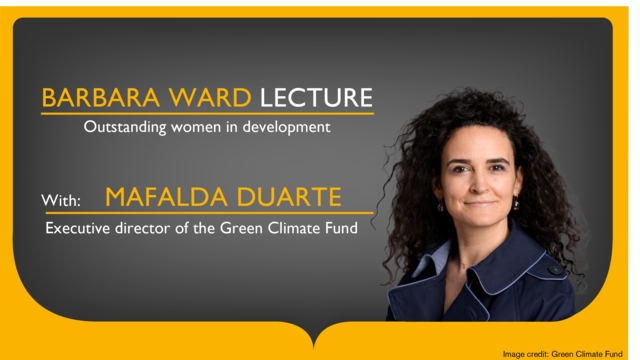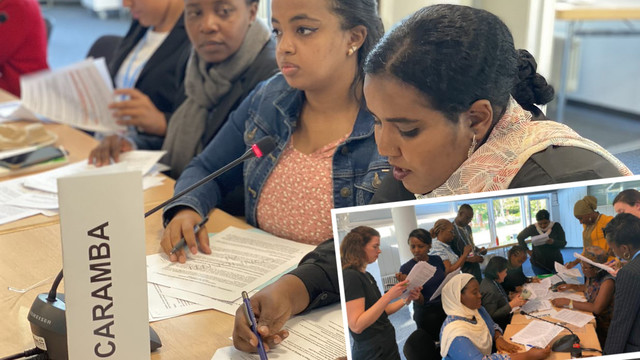LDC climate action plans estimated to cost US$93.7 billion per year
A report by IIED has estimated the cost of all 48 Least Developed Countries implementing their post-2020 climate action plans to be around US$93 billion per year.

The entrance to Le Bourget, the venue for the UN climate talks (COP21) (Photo: John Englart, CC BY-SA 2.0)
The 48 nations that make up the Least Developed Countries (LDCs) are proving to be among the most determined, committed and proactive on climate change.
Almost all the LDCs have outlined how they plan to contribute to post-2020 global climate action – through Intended Nationally Determined Contributions (INDCs) – ahead of the 2015 global climate summit in Paris (COP21). These contributions reflect the LDCs' commitment to an ambitious transformative shift to low-carbon, climate-resilient economies.
According to a paper produced by the International Institute for Environment and Development (IIED), 'A fair climate deal in Paris means adequate finance to deliver INDCs in LDCs', the cost for all LDCs to implement these post-2020 plans is estimated to be around US$93.7 billion each year — less than the 'new and additional' US$100 billion promised to all developing countries under the 2010 Cancun Agreements. However, less than a third of available climate finance reaches the LDCs.
A fair and effective deal in Paris should prioritise the investment of international public climate finance in the LDCs' implementation of their INDCs, while agreeing measures to help better-off developing countries to attract private climate finance.
- The data upon which the paper was published is available to download as a spreadsheet (Excel) (The file is also available as an older .xls file). This data was correct at the time of publishing (27 November 2015), and was produced according to the methods outlined below.
Methodology and caveats
Our analysis shows the scale of funding needed by LDCs to implement their INDCs. To arrive at these figures we investigated the full funding needs for climate finance as expressed in the INDCs versus the commitments from funders. To arrive at the full funding needs of INDCs we worked with available data in hand.
The information provided by countries is of varying levels of clarity. Therefore, estimates were made to produce a 'ballpark' figure for the total international financial support required to successfully implement both the adaptation and mitigation components of LDC INDCs.
The method used to estimate this international finance varied depending on the data supplied, which ranged significantly from country to country. When possible, financial data provided within the INDC was used, and when not available an extrapolation was performed using carbon emissions per country for mitigation requirements.
Across countries we see varying levels of clarity around adaptation versus mitigation finance, and international versus domestic sources of funding. Countries provide limited clarity on how they estimate international climate finance needs. Adaptation costs are also not as well estimated, with mitigation projects often clearly costed and explained within several countries INDCs. Adaptation is much more cross sectorial and nationwide making it much harder to estimate.
Many state that their development priorities are to adapt, and because of this recognition they are likely to be willing to spend more of their own domestic finance on adaptation, while wanting more international support for mitigation, which is not their most pressing priority.
It is understandable that the way in which this finance has been estimated is full of caveats; however, it is designed to simply highlight the ever growing need for climate finance from developed to developing countries. The methods deployed to estimate the international finance required for both mitigation and adaptation needs within LDC INDCs is further discussed below.
Forty-four of the 48 LDCs have submitted their INDCs to the UNFCCC, with Angola, Nepal, Timor-Leste and Tuvalu the only absentees. Despite more than 90 per cent of LDCs submitting their INDCs, only 15 provided fully costed international, or conditional financial needs for the implementation of their INDCs. Furthermore, six LDCs – Bhutan, Gambia, Mozambique, Myanmar, Malawi and Yemen – did not provide any "additional" finance estimates.
Consequently, in order to develop a full picture of LDC INDC needs, the missing financial needs, for both mitigation and adaptation were estimated. This however brought up numerous challenges:
- Definition of international finance: within the LDC INDCs most costings are split into "conditional" and "unconditional" finance requirements for planned mitigation, adaptation, capacity building and technology transfer projects and programmes. Within most INDCs, conditional was used interchangeably with international finance needs, while unconditional was used to outline those projects the LDC planned to finance through domestic means. Overall, conditional finance was assumed to represent international finance needs, unless specified within the INDC
- Period of implementation: although INDCs were originally designed to cover the period post-2020, many LDC INDCs varied considerably on both their start date and length of implementation, from as little as two (e.g. Somalia) to as long as 15 years (e.g. Eritrea). Furthermore, in some cases the time period varied within country LDCs, between adaptation and mitigation programmes.
It was attempted in all 42 cases to determine the start year and length of the INDC, however, where not possible it was assumed to be between 2020/21 to 2030. Given these variations, an average of 11.08 years for mitigation and 11.10 for adaptation was used, and
- Capacity building and technology transfer: in addition to mitigation and adaptation defined projects and programmes, several INDCs stated costed finance requests for capacity building and technology transfer activities, on average at three per cent of total finance. To simplify the analysis only mitigation and adaptation requests were analysed, therefore the total international finance estimated would increase by roughly 3.4 per cent when including these estimates.
When estimating international finance needs for INDC implementation, real LDC data was used whenever possible. Therefore, as a result of the varying data supplied within the INDCs, there were six different methods for estimating the missing costings:
- 15 LDCs provided fully costed international finance requests within their INDCs. Those countries which also provided domestic costs, 12 in total, were used to aid in the extrapolation of missing data, including: the average percentage of mitigation (55 per cent) and adaptation (42 per cent) finance requested; country and average LDC percentage of international finance requested (84 per cent); and annual international mitigation finance per country carbon emissions (US$0.0005 billion per LDC ktCO2e)
- 9 LDCs provided at least one of international and total mitigation, adaptation or total finance. This enabled the calculation of a LDC specific international finance ratio, from which the remaining finance gaps were filled
- 8 LDCs provided no international finance but fully costed total finance needs. The international finance was then calculated using the average international finance of 84 per cent
- 3 LDCs provided no total finance but one category of international finance, therefore the remaining missing data was filled using the LDC averages for mitigation and adaptation finance of 55 and 42 per cent respectively
- 3 LDCs provided only one total finance category, therefore the international finance was calculated in sequence of the equivalent international categories to the available data, using the combination of the above two methods, and
- Finally, 6 LDCs provided no costed estimates, so international finance needs were estimated by extrapolating with annual average international mitigation finance per country emissions (US$0.0005 billion per LDC ktCO2e), then combining the above method: using the average international finance of 84 per cent, and the average mitigation (55 per cent) and adaptation (42 per cent) for INDC finance for LDCs. The same method was performed to estimate potential INDCs costs for those four countries yet to submit their plans to the UNFCCC.
Due to these methodologies and the short timeframe of this exercise, estimating the finance needs for implementing LDC INDCs, it is clear that the aim was not to produce precise projections of financial needs, but a set of 'ballpark' figures which can be used to identify the rough overall trends of needs to help put LDCs on a low carbon development pathways and to adapt to the future impacts of climate change.
This analysis may lead onto a more in depth and rigorous study after COP21.


